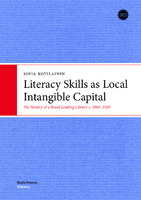Literacy Skills as Local Intangible Capital
The History of a Rural Lending Library c. 1860 - 1920
| dc.contributor.author | Kotilainen, Sofia | |
| dc.date.accessioned | 2018-01-08 23:55 | |
| dc.date.accessioned | 2017-12-01 23:55:55 | |
| dc.date.accessioned | 2018-01-08 00:00:00 | |
| dc.date.accessioned | 2020-04-01T13:16:52Z | |
| dc.date.available | 2020-04-01T13:16:52Z | |
| dc.date.issued | 2016 | |
| dc.identifier | 641489 | |
| dc.identifier | OCN: 1030822245 | en_US |
| dc.identifier.issn | 0355-8924;1458-526X | |
| dc.identifier.uri | http://library.oapen.org/handle/20.500.12657/30884 | |
| dc.description.abstract | "This book studies the ”grey area” of the success story of rural lending libraries in the Nordic countries through the activities of people’s libraries in one area of Central Finland. The study explores the influence of social, cultural, geographical and economic phenomena, such as the spread of revivalist movements, on the reading habits of the local population and reveals interesting reasons why the establishment of elementary schools and popular libraries and the growth of functional literacy did not automaticallyincrease the informational capital of the common people of remote regions or lead to their social advancement. This study represents a methodological experiment in describing the life history of a people’s library. The combination of collective biographical and transnational comparative methods with rarely utilized original sources in this study is innovative and has not been used before in Finnish historical research on functional literacy and popular libraries. The advantage of the comparison is that it reveals the attitudes to libraries that were characteristic of each of the cultures involved. For the people of the Finnish countryside in the late nineteenth century, libraries represented a way of acquiring new information that was still strange and unwelcome. The distribution of immaterial capital was extremely unevenwith regard to age, gender and social rank. In the earlier Finnish research has not very often been analysed, how the communal status of the peasant reader and his or her personal networks in the local community affected the quality of his or her reading habits. This book shows, that the location of the library in its local community and on the other hand the status and position of its customers in their networks, had a great significance on the use of the library and thus to the improvement of reading skills." | |
| dc.language | English | |
| dc.relation.ispartofseries | Studia Fennica Historica | |
| dc.subject.classification | thema EDItEUR::C Language and Linguistics::CF Linguistics::CFC Literacy | en_US |
| dc.subject.other | lending systems | |
| dc.subject.other | literacy | |
| dc.subject.other | countryside | |
| dc.subject.other | libraries | |
| dc.subject.other | Central Finland | |
| dc.subject.other | Church Village | |
| dc.subject.other | Finland | |
| dc.subject.other | Finnish language | |
| dc.subject.other | Kivijärvi | |
| dc.subject.other | Public library | |
| dc.subject.other | Saarijärvi | |
| dc.subject.other | Sweden | |
| dc.title | Literacy Skills as Local Intangible Capital | |
| dc.title.alternative | The History of a Rural Lending Library c. 1860 - 1920 | |
| dc.type | book | |
| oapen.identifier.doi | 10.21435/sfh.21 | |
| oapen.relation.isPublishedBy | 51db0f72-616d-4d86-b847-ade19380e08f | |
| oapen.relation.isFundedBy | f2ba3da1-e4a8-41c9-9a78-bf7b19984191 | |
| oapen.relation.isbn | 9789522227966;9789522227393 | |
| oapen.series.number | 21 | |
| oapen.pages | 368 | |
| oapen.place.publication | Helsinki | |
| oapen.remark.public | Relevant Wikipedia pages: Central Finland - https://en.wikipedia.org/wiki/Central_Finland; Church Village - https://en.wikipedia.org/wiki/Church_Village; Finland - https://en.wikipedia.org/wiki/Finland; Finnish language - https://en.wikipedia.org/wiki/Finnish_language; Kivijärvi - https://en.wikipedia.org/wiki/Kivij%C3%A4rvi; Lending library - https://en.wikipedia.org/wiki/Lending_library; Literacy - https://en.wikipedia.org/wiki/Literacy; Public library - https://en.wikipedia.org/wiki/Public_library; Saarijärvi - https://en.wikipedia.org/wiki/Saarij%C3%A4rvi; Sweden - https://en.wikipedia.org/wiki/Sweden | |
| oapen.identifier.ocn | 1030822245 |

